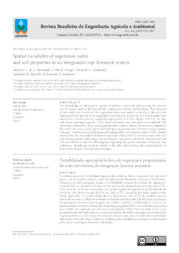Spatial variability of vegetation index and soil properties in an integrated crop-livestock system.
Spatial variability of vegetation index and soil properties in an integrated crop-livestock system.
Author(s): BERNARDI, A. C. de C.; GREGO, C. R.; ANDRADE, R. G.; RABELLO, L. M.; INAMASU, R. Y.
Summary: ABSTRACT - The knowledge of soil property spatial variability is useful for determining the rational use of inputs, such as the site-specific application of lime and fertilizer. The objective of this study was to evaluate the vegetation index and spatial variability of physical and chemical soil properties in an integrated crop-livestock system (ICLS). Soil samples were taken from a 6.9 ha area in a regular hexagon grid at 0-0.20 m depths. Soil P, K, Ca, Mg, and cation exchange capacity - CEC; base saturation; clay and sand were analyzed. Soil electrical conductivity (ECa) was measured with a contact sensor. The site was evaluated at the end of the corn season (April) and during forage production (October) using Landsat 5 images, remote sensing techniques and a geographic information system (GIS). Results showed that the normalized difference vegetation index (NDVI) was associated with ECa and soil parameters, indicating crop and pasture variations in the ICLS. Geostatistics and GIS were effective tools for collecting data regarding the spatial variability of soil and crop indicators, identifying variation trends in the data, and assisting data interpretation to determine adequate management strategies. O conhecimento da variabilidade espacial dos atributos físicos e químicos do solo é útil para o uso racional de insumos, como na aplicação localizada de corretivos e fertilizantes. Objetivou-se, nesta pesquisa, avaliar a variabilidade espacial dos índices de vegetação e atributos físicos e químicos do solo em um sistema de integração lavoura-pecuário (ILP). Uma área de 6,9 ha foi amostrada com grade regular hexagonal na profundidade de 0-0,20 m. Os valores no solo de P, K, Ca, Mg, e CTC, saturação por bases, argila e areia foram analisados. A condutividade elétrica aparente do solo (CEa) foi medida com um sensor de contato. O talhão foi avaliado no final do ciclo do milho (abril) e para a produção de pastagem (outubro) por imagens do satélite Landsat 5, utilizando-se técnicas de sensoriamento remoto e sistemas de informação geográfica (SIG). Os resultados mostraram que o índice de vegetação por diferença normalizada (NDVI) foi associado à CEa e aos parâmetros de solo indicando as variações da cultura do milho e pastagem em sistema ILP. A geoestatística e o SIG foram ferramentas eficazes para unir os dados de variabilidade espacial do solo e da cultura, indicar as tendências dos resultados e interpretar a informação para apoiar estratégias de manejo adequadas.
Publication year: 2017
Types of publication: Journal article
Unit: Embrapa Dairy Cattle
Keywords: ILPF, Landsat 5, NDVI, Soil electrical conductivity, VERIS, soil fertility
Observation
Some of Embrapa's publications are published as ePub files. To read them, use or download one of the following free software options to your computer or mobile device. Android: Google Play Books; IOS: iBooks; Windows and Linux: Calibre.
Access other publications
Access the Agricultural Research Database (BDPA) to consult Embrapa's full library collection and records.
Visit Embrapa Bookstore to purchase books and other publications sold by Embrapa.

